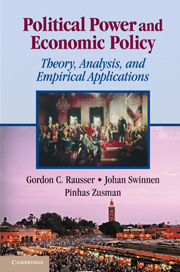Book contents
- Frontmatter
- Contents
- List of Figures
- List of Tables
- Preface
- PART 1 POLITICAL POWER AND ECONOMIC ANALYSIS
- PART 2 IDEOLOGY, PRESCRIPTION, AND POLITICAL POWER COEFFICIENTS
- PART 3 ANALYSIS OF SPECIFIC STRUCTURES
- 10 The Political Economy of Commodity Market Intervention
- 11 The Political Economy of Public Research and Development
- 12 Political-Economic Analysis of Redistributive Policies and Public Good Investments
- 13 Interest Groups, Coalition Breaking, and Productive Policies
- 14 Policy Reform and Compensation
- 15 Political-Economic Analysis of Land Reform
- 16 Political-Economic Analysis of Water Resource Systems
- 17 The Political Economy Lens on Quality and Public Standard Regulations
- 18 Political-Economic Analysis in Transition Economies
- 19 The Power of Bureaucracies: The European Commission and EU Policy Reforms
- PART 4 EMPIRICAL APPLICATIONS OF POLITICAL POWER ESTIMATION
- References
- Index
10 - The Political Economy of Commodity Market Intervention
Published online by Cambridge University Press: 05 June 2012
- Frontmatter
- Contents
- List of Figures
- List of Tables
- Preface
- PART 1 POLITICAL POWER AND ECONOMIC ANALYSIS
- PART 2 IDEOLOGY, PRESCRIPTION, AND POLITICAL POWER COEFFICIENTS
- PART 3 ANALYSIS OF SPECIFIC STRUCTURES
- 10 The Political Economy of Commodity Market Intervention
- 11 The Political Economy of Public Research and Development
- 12 Political-Economic Analysis of Redistributive Policies and Public Good Investments
- 13 Interest Groups, Coalition Breaking, and Productive Policies
- 14 Policy Reform and Compensation
- 15 Political-Economic Analysis of Land Reform
- 16 Political-Economic Analysis of Water Resource Systems
- 17 The Political Economy Lens on Quality and Public Standard Regulations
- 18 Political-Economic Analysis in Transition Economies
- 19 The Power of Bureaucracies: The European Commission and EU Policy Reforms
- PART 4 EMPIRICAL APPLICATIONS OF POLITICAL POWER ESTIMATION
- References
- Index
Summary
Introduction
Commodity markets are characterized by trade in standardized, undifferentiated goods and numerous transactors or traders. Consequently, such markets are highly competitive, and trade is carried out at concentrated, low-transaction-cost exchanges. As a result, commodity markets are among the closest approximations to the ideal neoclassical competitive market. To the degree that commodity markets are free of externalities, the resulting market equilibria represent the first best outcome.
Nevertheless, owing to imperfect foresight, possible chaotic behavior, and random shocks, the dynamic performance of commodity markets may be sub-optimal. Commodity markets' actual performance as exchange institutions may at times fall short of the theoretical ideal. Hence, from a public policy perspective room exists for efficiency-enhancing intervention in the form of setting commodity quality standards, disseminating relevant transparent market information, and establishing appropriate market regulations. In addition, commodity market stabilization programs offer a wide scope for improving the dynamic market performance. However, market stabilization objectives are often invoked as a justification for achieving “orderly” transactions as a mask for redistributive transfers from one interest group to another (Rausser 1992).
The analytic aim of this chapter is to explore the formation of transfer seeking policy intervention in commodity markets. To keep the analysis as straightforward as possible, problems of uncertainty and instability are ignored. The analysis focuses on the political economy of transfer-seeking intervention, employing the political power approach to endogenous policy formation (Chapter 4).
The static economic structure of commodity markets typically begins with a set of supply and demand equations.
- Type
- Chapter
- Information
- Political Power and Economic PolicyTheory, Analysis, and Empirical Applications, pp. 193 - 208Publisher: Cambridge University PressPrint publication year: 2011



